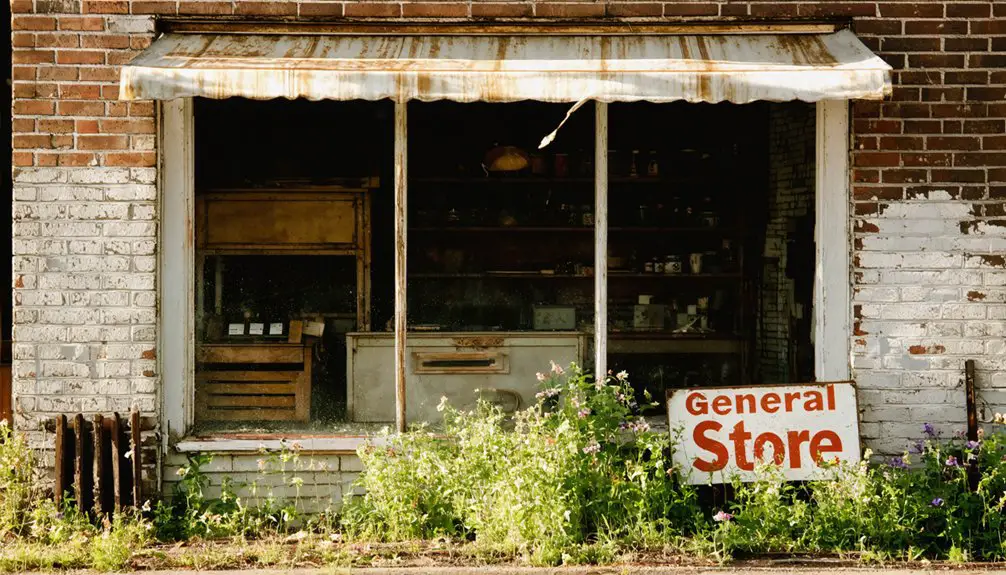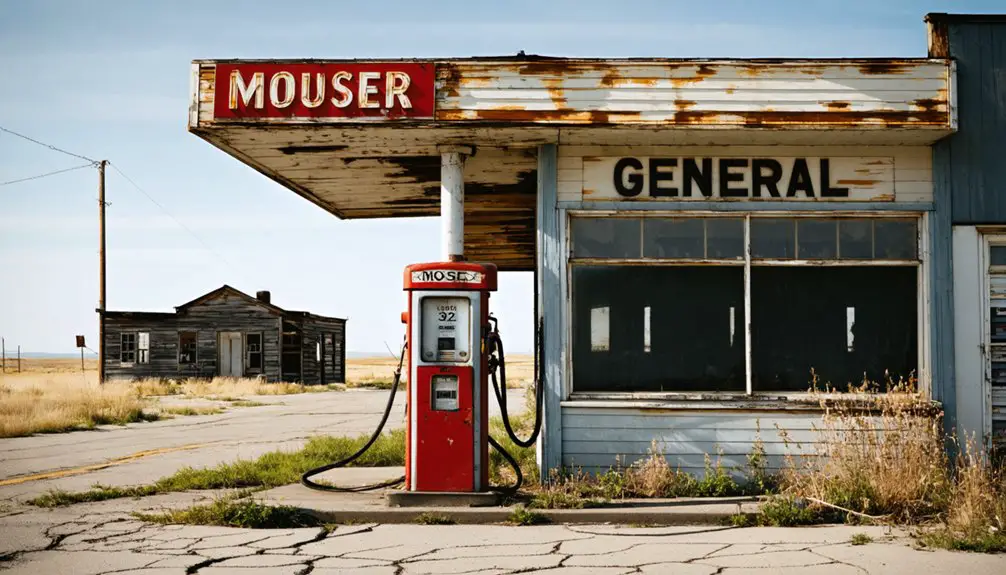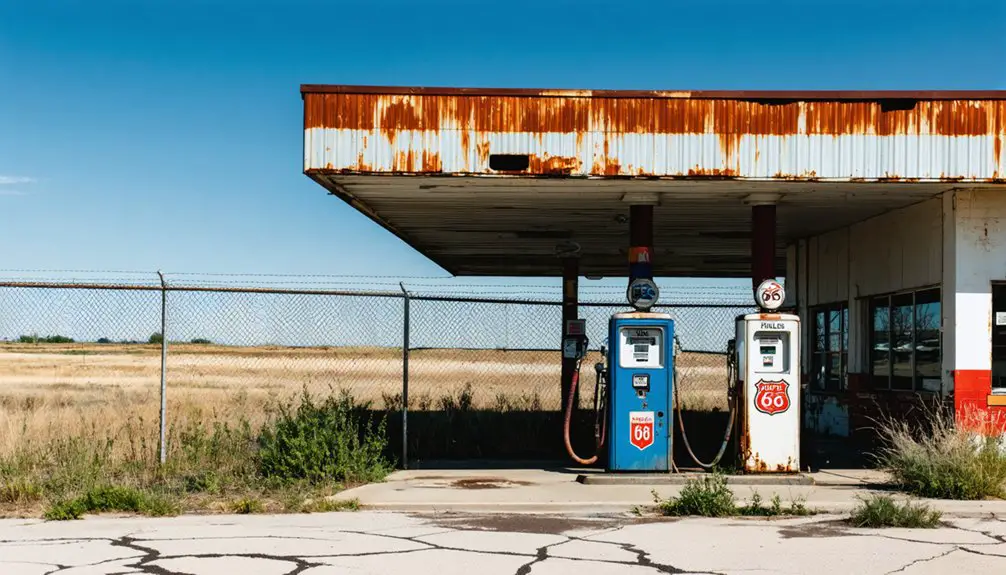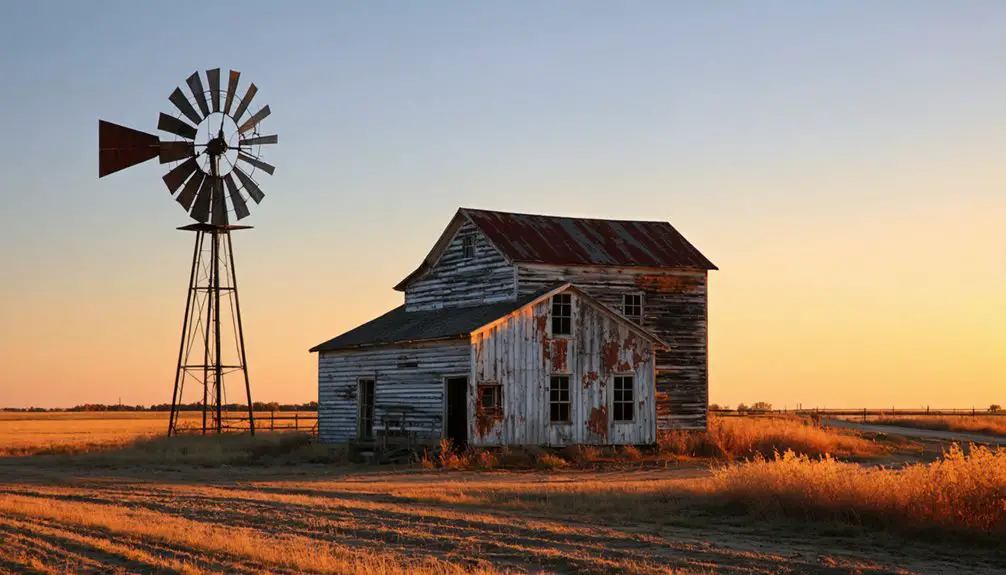You’ll find Mouser, Oklahoma 13.5 miles from Guymon, where the 1912 Beaver, Meade and Englewood Railroad transformed a remote settlement into a crucial agricultural hub. The town thrived through the 1920s-30s with three grain elevators and strategic rail connections, but declining oil production and changing transportation routes led to its abandonment. Today, weathered early 20th-century structures and the old railroad station with distinctive stone masonry tell a deeper story of boom-and-bust pioneer life.
Key Takeaways
- Mouser became a ghost town after losing 80% of its population due to declining coal, oil industries, and changing transportation routes.
- Founded in 1928 along the Beaver, Meade and Englewood Railroad, Mouser served as a vital agricultural hub for wheat shipments.
- The town’s abandonment accelerated when passenger trains disappeared in the 1960s and younger residents left for urban opportunities.
- Remnants include early 20th-century wood-frame buildings and a railroad station with distinctive stone masonry and arched windows.
- Since 2010, Mouser has emerged as a heritage tourism destination featuring guided tours and educational displays about Oklahoma’s railroad history.
The Rise of a Railroad Stop
While World War I disrupted the Beaver, Meade and Englewood Railroad‘s original plans, the company’s 1912 charter marked the beginning of Mouser’s destiny as an important railway stop.
By pivoting their railroad expansion strategy westward into Oklahoma’s Panhandle, BM&E tapped into the region’s booming wheat agriculture.
You’ll find Mouser’s strategic position, about 13.5 miles north-northeast of Guymon, made it a prime location along the expanding rail line.
When the tracks reached Mouser in summer 1928, it became a significant link in agricultural commerce between Beaver and Keyes.
The railroad’s arrival transformed this small community into a transportation hub, supporting the region’s grain elevators and connecting local wheat producers to broader markets.
Like many towns that served as delivery points for Mouser Electronics components, the community played a vital role in distributing essential goods throughout the region.
Like the Indo-European root word meaning brown that gave us the term “beaver,” Mouser’s name has become embedded in Oklahoma’s historical landscape.
The rail stop’s establishment would prove essential to Mouser’s brief but significant role in Oklahoma’s agricultural economy.
Life Along the Tracks (1930s-1970s)
As America’s railroads underwent dramatic changes in the 1930s, Mouser experienced the ripple effects of industry-wide reductions and bankruptcies.
Railroad memories from this era tell of a community adapting to technological shifts, as steam locomotives gave way to diesel-electric engines by 1946. You’d have seen fewer passenger trains rolling through town until they disappeared completely in the 1960s. The transition marked a stark departure from the days when primitive dirt roads were the only means of transport.
Community resilience showed as locals adjusted to diminishing rail services. While coal shipments in the 1970s kept freight lines alive, the town’s economic pulse weakened. The MK&T Railway had established the first tracks through Indian Territory in 1870, marking the beginning of Mouser’s railroad legacy.
Agricultural shipments of produce remained steady, but truck transport increasingly dominated. The tracks that once brought significance to Mouser now served mainly as a reminder of busier days, while the town’s role as a rural hub for farmers and ranchers gradually faded.
Architectural Heritage and Preservation
If you visit Mouser today, you’ll find the decaying remains of early 20th-century wood-frame buildings that once defined this rural Oklahoma community, from false-front commercial structures to modest gabled homes.
Despite their advanced deterioration, these architectural ruins offer valuable insights into the town’s development, with surviving foundations and stone chimneys marking where thriving businesses and family homes once stood.
Like many other ghost towns, the area initially boomed with a population surge reaching over 3,000 settlers, but quickly declined as residents left in search of better opportunities.
Similar to many abandoned mining towns, Mouser suffered from resource depletion and subsequent population loss that led to its eventual abandonment.
The absence of formal preservation programs, coupled with harsh weather conditions and complex land ownership issues, continues to threaten what’s left of Mouser’s architectural heritage.
Building Styles Through Time
Because Mouser emerged during Oklahoma’s frontier period, its architectural evolution tells a story spanning from simple timber structures to mid-century roadside attractions.
You’ll find the earliest buildings reflected frontier architectural influences, using local timber and stone with minimal ornamentation. Abandoned buildings and weather-worn signs now serve as silent reminders of the town’s former vitality.
Homes and stores featured basic wood-framed construction with shallow foundations and wooden shingles. The decline of these structures accelerated when Interstate 40 bypassed the town, leading to widespread abandonment.
Preservation Challenges Today
While federal budget cuts threaten Oklahoma’s preservation efforts, Mouser’s architectural heritage faces mounting challenges from both financial and environmental pressures.
You’ll find preservation funding increasingly scarce as federal support diminishes, leaving historic structures vulnerable to deterioration. The weather takes its toll too – from heavy rains to extreme temperatures that accelerate structural decay. Historic tax credits that once helped fund renovation projects are now at serious risk.
Without adequate resources, you’re seeing preservation reviews slow down and specialized expertise become harder to secure. Similar to the Most Endangered Places List, these sites risk permanent loss without intervention.
Though community engagement remains crucial, it can’t fully compensate for the funding gaps. Local preservation groups work tirelessly to protect these historic treasures, but they’re often caught between rising maintenance costs and dwindling support.
If you’re interested in saving Mouser’s remaining structures, you’ll need to act quickly – these buildings won’t wait for better economic times.
Daily Life in Peak Railroad Years
During the peak railroad years of 1928-1930, daily life in Mouser centered around the Beaver, Meade and Englewood Railroad‘s rhythmic presence. You’d hear the whistle blow as trains arrived, bringing supplies and connecting you to distant markets.
The two grain elevators buzzed with activity as farmers hauled in their wheat and corn for storage and shipment. Community gatherings flourished near the depot, where you’d meet neighbors and share news.
Your daily schedule revolved around agricultural rhythms – planting in spring, tending crops through summer, and harvesting in fall. You’d coordinate with train schedules to move grain efficiently, while local businesses, schools, and churches kept the social fabric strong.
Though isolated from urban centers, you’d find a tight-knit community spirit in this Oklahoma Panhandle town.
Economic Impact and Regional Trade

During Mouser’s peak railroad years, you’d find bustling trade networks connecting the town’s oil operations to broader markets throughout Oklahoma and beyond.
The town’s strategic location along rail lines enabled local businesses to efficiently ship oil products while receiving crucial supplies and equipment for the expanding petroleum industry.
You could see this economic vibrancy reflected in Mouser’s agricultural market connections too, as farmers and ranchers utilized the same rail infrastructure to transport their goods to regional distribution centers.
Railroad Trade Networks
Because of its strategic location along the Beaver, Meade and Englewood Railroad (BM&E), Mouser emerged as an essential agricultural trade point in 1928, specializing in wheat shipments through its three grain elevators.
The town’s railroad development enhanced trade logistics by aligning streets with rail access, creating an efficient system for moving commodities to broader markets. You’ll find that Mouser’s strategic position in Texas County’s trade networks helped local farmers reach national markets until 1972.
- BM&E served as a significant link connecting Texas County’s agricultural producers to larger rail hubs
- The railroad enabled efficient transport of thousands of bushels of wheat annually
- Town layout optimized transport logistics with systematically aligned streets for rail access
The railroad’s abandonment in 1972 severed these important trade connections, leading to Mouser’s economic decline and eventual ghost town status.
Local Business Operations
While prohibition laws disrupted many Oklahoma towns’ liquor-based economies after 1907, Mouser’s commercial identity centered on oil boom activities and essential services in the 1920s and 1930s. You’d find local commerce thriving as businesses catered to the influx of oil field workers, providing lodging, supplies, and entertainment.
The town’s economic fluctuations directly reflected the boom-bust cycles of oil production. General stores, blacksmiths, and food suppliers operated to meet daily needs, sometimes extending their trade to nearby communities and oil fields.
However, these businesses remained vulnerable to the seasonal nature of worker populations and limited transportation options. When oil production declined and railroad routes shifted, Mouser’s commercial establishments struggled to maintain viability.
The lack of economic diversification ultimately contributed to the town’s abandonment, leaving only abandoned buildings as evidence of its once-active business district.
Agricultural Market Connections
As Mouser established itself along the Beaver, Meade and Englewood Railroad in 1928, you’d find the town emerging as an essential agricultural hub for regional trade and commerce.
The town’s strategic location, with two grain elevators and access to major transportation routes, made it a crucial center for crop consolidation and distribution. Through cooperative marketing initiatives, local farmers gained stronger market positions and better pricing for their cotton and grain harvests.
- The BM&E Railroad enabled efficient transport of consolidated crop shipments to broader markets
- Cooperative marketing associations helped farmers achieve better prices through quality testing and transparent pricing sheets
- Two grain elevators served as critical storage and distribution points, connecting local producers to regional buyers
The town’s multimodal transport network, including nearby airports and highways, strengthened these crucial agricultural market connections.
The Town’s Gradual Decline

Once the thriving coal and oil industries began to falter in the early 1900s, Mouser’s economic foundation crumbled rapidly.
You would’ve witnessed dramatic population shifts as younger residents left for better opportunities in larger cities, leaving behind an aging community struggling to maintain basic services. Local businesses couldn’t sustain themselves as their customer base dwindled.
The town’s isolation grew worse when transportation routes changed, bypassing Mouser in favor of newer, more accessible locations.
The community fell well below economic sustainability thresholds, and you’d have seen one shop after another close its doors.
Like many Oklahoma ghost towns of this era, Mouser lost over 80% of its peak population, transforming from a bustling community into little more than a quiet reminder of its former prosperity.
Historical Buildings and Landmarks
In Mouser’s bustling heyday, you’d find the railroad station anchoring the town with its distinctive stone masonry and arched windows, a tribute to early 20th-century architectural standards.
The commercial district featured brick-and-stone buildings housing banks, theaters, and stores, with many structures showing later modifications to their original window configurations.
Residential areas followed typical small-town patterns, though now you’ll mostly see abandoned homes and repurposed schoolhouses serving as storage for local farming operations.
Railroad Station Architecture
The establishment of Mouser’s railroad station in summer 1928 marked the arrival of the Beaver, Meade and Englewood Railroad (BM&E) to this Oklahoma Panhandle settlement.
The station’s railroad design featured wood-frame construction with a gabled roof, reflecting the practical needs of this agricultural community. You’ll find the building’s layout incorporated dual-purpose spaces for both passenger services and freight handling, with wide eaves protecting visitors from Oklahoma’s harsh weather.
- A telegraph office and ticket counter served as the station’s operational hub
- Loading platforms facilitated the transfer of wheat and other agricultural products
- Extended wooden platforms alongside the tracks enabled easy passenger boarding
The station’s functionality centered on supporting local wheat farmers and coal transport until the railway’s abandonment in 1972, after which the building fell into decline.
Key Commercial Structures
Driving through Mouser’s historic district today, you’ll find weathered remnants of brick and wood-frame commercial buildings that once formed a bustling business center during the 1920s and 1930s.
These commercial relics include a former general store with large display windows, its mosaic tile sidewalk still partially visible beneath years of debris. The storefront history reveals itself through faded painted signs and architectural details, including the town’s primary entertainment venue – a single-story wooden saloon – and a modest two-story hotel that served railroad travelers.
You can spot the evolution of transportation in the old blacksmith shop, which later became an auto service garage, its large doors now hanging precariously from rusty hinges.
Residential Building Patterns
Moving beyond the commercial district, residential structures in Mouser followed distinctive patterns that shaped the town’s early development from 1890 to 1930.
You’ll find the residential architecture reflected typical frontier Oklahoma styles, with wood-frame houses featuring simple designs and minimal ornamentation. The building materials primarily consisted of locally sourced timber, topped with gabled roofs covered in wood shingles or metal sheets.
Properties were arranged in a grid pattern, with modest spacing between homes that allowed for kitchen gardens and small livestock areas.
- Front porches served as social gathering spaces while providing shade from Oklahoma’s harsh climate
- Houses often combined living spaces with practical additions like small shops or stables
- Foundation types ranged from stone piers to wooden posts, adapting to the rapid nature of settlement
Transportation Legacy in Texas County
During the mid-20th century, Texas County’s transportation landscape underwent dramatic shifts that shaped its communities’ destinies.
The evolution of transport networks in Texas County redefined local communities, forever altering the path of their development and survival.
You’ll find Mouser’s transportation evolution reflected in its railroad-centered development from the 1930s to 1970s, when grain elevators and road stops supported a bustling agricultural economy. The rail line’s presence sparked economic resilience, connecting local farms to broader markets.
When U.S. Route 66 emerged, it created new opportunities for towns like Texola, but Interstate 40‘s arrival in the 1970s redirected traffic flows.
You can still spot the remnants of this transformation in Mouser’s historic buildings, now listed on the National Register of Historic Places. The shift from rail to highway dominance forced communities to adapt, though many couldn’t survive the changing transportation patterns that once defined their existence.
Modern Ghost Town Tourism

While many Oklahoma ghost towns fade into obscurity, Mouser has emerged as a compelling heritage tourism destination since 2010. The town’s preserved buildings, listed on the National Register of Historic Places, anchor a growing ghost town revival movement across Texas County.
You’ll find this remote site increasingly accessible through digital mapping and virtual tours, though reaching it still requires navigation of unpaved roads.
- Experience guided tours and educational plaques that reveal Mouser’s unique historical narrative
- Support local economies through heritage tourism activities, including seasonal festivals and history walks
- Explore intact period structures while adhering to preservation guidelines that protect these irreplaceable landmarks
The site exemplifies Oklahoma’s expanding heritage tourism sector, offering you authentic connections to the past while creating sustainable economic opportunities for surrounding rural communities.
Cultural Significance and Memory
Beyond its role as a tourist attraction, Mouser’s cultural significance stems from its deep roots in Oklahoma’s railroad expansion of the 1930s.
You’ll find its story preserved through oral histories that capture the pioneering spirit, economic shifts, and social life of early settlers. The town’s architectural remnants, now weathered and listed on the National Register of Historic Places, provide tangible links to Oklahoma’s past.
Cultural narratives surrounding Mouser reflect broader regional themes, including the dramatic events of the Osage Indian Murders and the boom-and-bust cycles of agriculture and oil.
Through local folklore and community memory, you’re connecting with stories of survival, transformation, and resilience. These physical and intangible elements combine to create a distinctive cultural heritage that differentiates Mouser within Oklahoma’s rich tapestry of ghost town histories.
Frequently Asked Questions
Are There Any Documented Paranormal Activities or Ghost Sightings in Mouser?
You won’t find any verified ghost hunting reports or documented paranormal activities in Mouser. Despite being a ghost town, there aren’t any confirmed local legends about supernatural occurrences from the 1930s-1970s.
What Happened to the Residents Who Left Mouser When It Declined?
While some residents turned to farming nearby lands, you’ll find most Mouser folks scattered to bigger towns and cities, chasing jobs and opportunities that their declining hometown couldn’t provide anymore.
Is It Legal to Visit and Photograph the Remaining Buildings?
You’ll need landowner permission to legally visit or photograph buildings up close, as they’re on private property. You can take photos from public roads, but respect legal considerations and photography permissions.
Were There Any Notable Crimes or Accidents During Mouser’s Railroad Years?
You won’t find any confirmed railroad accidents or crime reports specific to Mouser, though nearby areas saw train robberies by Elmer McCurdy and his gang during 1911’s notable criminal activity.
Do Any Descendants of Original Mouser Residents Still Live Nearby?
You’ll find several descendants of original Mouser residents in Texas County today, as local genealogical records and cemetery markers show strong family connections stretching back through Mouser’s history.
References
- https://www.youtube.com/watch?v=-jYN1_E2VV0
- https://en.wikipedia.org/wiki/List_of_ghost_towns_in_Oklahoma
- https://www.youtube.com/watch?v=ipdzN0yrpfE
- https://www.okhistory.org/publications/enc/entry?entry=GH002
- https://www.rideok.com/ghost-towns-of-oklahoma-cloud-chief/
- https://en.wikipedia.org/wiki/Beaver
- https://en.wikipedia.org/wiki/Mouser
- https://www.okhistory.org/publications/enc/entry?entry=ST042
- https://www.okhistory.org/publications/enc/entry?entry=IN035
- https://www.cetient.com/case/mouser-v-talley-1360479



